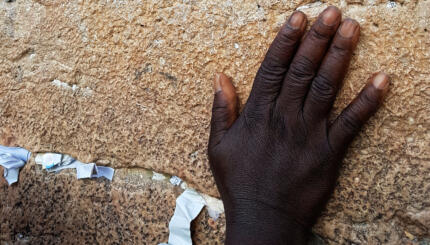Jewish prayer relies heavily on music. Dating back at least to the times of the First Temple in Jerusalem, Levites had the responsibility of singing and playing instruments as part of the Temple service, which centered around sacrificial practices. With the exile of the Jewish people in 70 C.E., the focus of Jewish worship shifted from sacrifice to the recitation of texts.
The recounts the formation of the basic components of the siddur (prayerbook). At the time, the national literacy level was low, and most Jews had to memorize the essential prayers; in almost every “oral” tradition such as this, music is used to aid memorization. We have no way of knowing what early prayer chanting sounded like. One thing seems clear, though: The primary purpose of chanting non-poetic texts is to convey the meaning of the words; the structure and decorativeness of the music must have been secondary.

The destruction of the Second Temple also served as the catalyst for a vast change in the music of worship. In the Temple, the Levites had employed instruments–drums, cymbals, horns, lyres, trumpets–but after the destruction of the Temple, the rabbis forbade the use of instruments during prayer. Two reasons for this proscription have been suggested. First, the absence of musical instruments would serve as a sign of mourning for the Temple. Second, the rabbis of the Talmud opposed the use of instruments in prayer services because of their anti-Hellenistic sentiments.

Help us keep Jewish knowledge accessible to millions of people around the world.
Your donation to My Jewish Learning fuels endless journeys of Jewish discovery. With your help, My Jewish Learning can continue to provide nonstop opportunities for learning, connection and growth.
While prayer was ideally undertaken by each individual, the Talmud provided for cases of illiteracy through the institution of the shaliah tzibbur (messenger of the community); in this context, music takes on an important role in prayer. The shaliah tzibbur was to chant the liturgical texts aloud, with the intention that that prayer could function for the entire congregation. The role of shaliah tzibbur developed into the role of hazzan (cantor), whose responsibility was not only to pray on behalf of the community, but also to sing the service well.
In many regions, cantorial music became a venue for vocal virtuosity; recordings of hazzanim like Israel Alter and Yossele Rosenblatt provide only a glimpse of the Eastern European tradition of cantorial music. The basic melodies of the hazzan are determined by the nusah (melodic formula) of the day: The nusah of the Sabbath differs from that of weekdays, the nusah of the Days of Awe differs from the festivals, etc.
While nusah is generally fixed within a given community, there are vast differences among the sounds of different communities. In addition, basic nusah may be expanded upon and embellished. Many large European congregations of the 18th and 19th centuries housed choruses that accompanied the cantor; they assembled a vast repertoire of choral music that stands out as one of the great achievements of Jewish music.
In addition to liturgical chanting, many days require the chanting of portions of the Pentateuch, Prophets, or Writings. The notation for these melodies was fixed by a group of sixth-century scholars known as the Masoretes (from the Hebrew mesorah, “tradition”). Like nusah, the sounds of each Masoretic cantillation mark differ with each community, and the modes and sounds of the cantillation differ depending on the type of text being read.
As early as the fifth century, Jewish authors–many of them cantors–introduced metered poetry called piyyutim into the synagogue service. In piyyutim, both the words themselves and the rhythm of the words are important, so these poems naturally lend themselves to structured, rhythmic singing. The texts of piyyutim are often set in the musical idioms of the host country. In the 16th century, the Italian composer Salamone Rossi composed settings of these poems similar to contemporaneous secular madrigals and church music, and it is clear that they were used in actual synagogue services.
In the past two centuries, synagogue music has changed dramatically. In the early 20th century, Abraham Idelsohn attempted to codify the nusah of the entire Jewish community; his concordance of Jewish melodies disseminated in print a tradition which had until then been almost entirely oral. Congregations in the early Reform movement in 19th-century Germany reintroduced the use of instruments such as organs in the Sabbath service, and even some traditional communities began to allow the use of instruments in non-Sabbath worship.
 More recently, other instruments have been added to services; for example, folk-influenced cantors have incorporated guitars into their prayer. In the past few decades, Reform cantors and song-leaders such as Debbie Friedman have introduced new music, both in Hebrew and English, into the liturgy. The Orthodox community has largely drifted away from the employment of a professional hazzan, choosing instead to encourage the active participation of congregants. Rabbi Shlomo Carlebach, influenced by the populist musical tradition of the
movement, composed hundreds of niggunim (melodies) for use both in and out of the synagogue, and communities of all denominations use his music to enhance the prayer experience.
More recently, other instruments have been added to services; for example, folk-influenced cantors have incorporated guitars into their prayer. In the past few decades, Reform cantors and song-leaders such as Debbie Friedman have introduced new music, both in Hebrew and English, into the liturgy. The Orthodox community has largely drifted away from the employment of a professional hazzan, choosing instead to encourage the active participation of congregants. Rabbi Shlomo Carlebach, influenced by the populist musical tradition of the
movement, composed hundreds of niggunim (melodies) for use both in and out of the synagogue, and communities of all denominations use his music to enhance the prayer experience.


